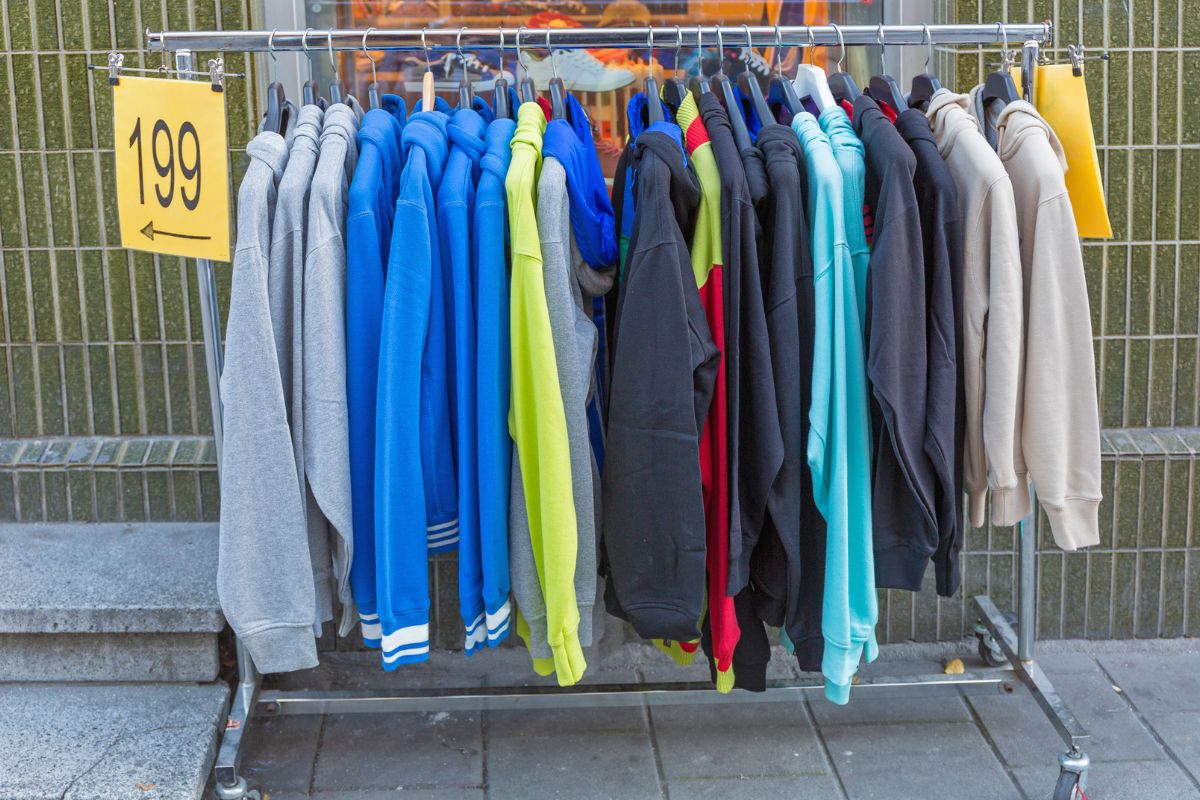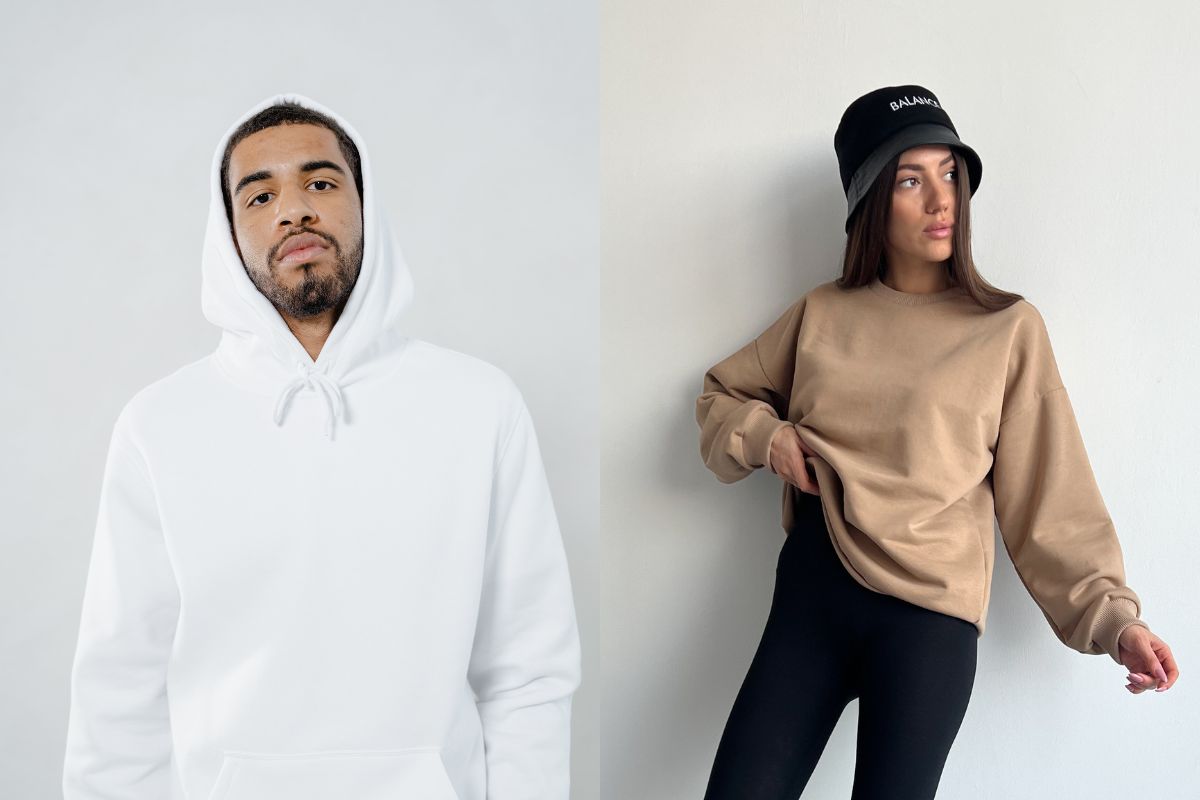When you think about cozy clothing, hoodies and sweatshirts often come to mind.
The main difference between a hoodie and a sweatshirt is that a hoodie includes a hood, while a sweatshirt does not. This simple feature changes how each garment looks and feels, making them suitable for different occasions.
Both items are popular choices for casual wear, offering comfort and style. Hoodies provide extra warmth and a relaxed look, perfect for cooler weather or lounging around.
Table of contents
- Historical Evolution
- Design and Construction
- Materials and Fabric Types
- Functional Considerations
- Fashion and Style
- Comparison and Contrast
- Buying Guide
- Cultural Impact and Iconography
- Frequently Asked Questions
- What distinguishes a hoodie from a jacket?
- Can a sweatshirt be considered a hoodie if it lacks a hood?
- Does a zippered hoodie have a specific name?
- What are the warmth differences between sweatshirts and hoodies?
- How do sweatshirts differ from sweaters?
- What are the main differences between a crew neck and a hoodie?
Sweatshirts, on the other hand, come in classic designs and are versatile enough to wear on various occasions, from running errands to hanging out with friends.
Understanding these differences can help you choose the right garment for your needs.
Whether you prefer the warmth of a hoodie or the classic style of a sweatshirt, knowing what each offers allows you to make an informed decision about your wardrobe.
Historical Evolution
The hoodie and sweatshirt have distinct origins and developed uniquely over time. Understanding their historical paths provides insight into their significance in fashion and culture.
Origins of Hoodies
Hoodies trace their roots back to the early 20th century. Originally designed for athletes, they were made to keep wearers warm during training and competitions.
The first hooded sweatshirts appeared in the 1930s, crafted from warm fabrics like French terry, which is soft and absorbent.
By the 1960s, hoodies gained popularity among sports figures. They became common attire for athletes, but this was just the beginning. In the 1970s, the hoodie entered the realm of hip-hop culture, becoming a symbol of urban style and rebellion.
Development of Sweatshirts
Sweatshirts have a similarly rich history. They emerged in the 1920s to provide comfort for athletes. Made from cotton, these garments offered ease of movement and warmth.
The sweatshirt’s design evolved over the decades, with key features like crew necklines and varied materials. In the 1980s, it became prevalent in casual wear and was seen in pop culture, from television to movies.
Today, sweatshirts come in various styles, emphasizing comfort and versatility. They are made from diverse materials, including cotton blends, making them fit for casual settings and fashion-forward looks.
Design and Construction
| Feature | Hoodie | Sweatshirt |
|---|---|---|
| Design | Features a hood (with or without drawstrings), often includes a front pocket. | Simple, no hood, usually pullover style. |
| Best Season to Wear | Fall, Winter, or cooler evenings. | Fall, Spring, or casual indoor settings. |
| Best for | Outdoor activities, casual outings, layering for warmth. | Casual office wear, laid-back styles, indoor comfort. |
| Level of Warmth | Generally warmer due to the hood and thicker material. | Warmer than a t-shirt, but less insulating than a hoodie. |
| Style | Casual, sporty, or streetwear vibe. | Classic, laid-back, or preppy look. |
| Comfort | Offers extra warmth around the head and neck. | More breathable, ideal for layering. |
| Layering Ability | Works well as an outer layer or mid-layer. | Works well as an inner layer, but can also be worn alone. |
| Movement | Can limit head movement or visibility when wearing the hood. | More freedom of movement, less restriction. |
| Durability | Usually more durable with reinforced hoods and pockets. | Simple construction, generally durable but less feature-heavy. |
| Pros | – Provides extra warmth. – Versatile for different weather. – Can be used for a sporty or streetwear look. | – Lightweight and breathable. – Can be dressed up or down. – Easier to style for semi-casual occasions. |
| Cons | – Bulky for some outfits. – Can get too warm in milder weather. – The hood can be uncomfortable in windy conditions. | – Less warmth compared to a hoodie. – Doesn’t provide head protection. – May not feel as cozy in cold weather. |
The design and construction of hoodies and sweatshirts highlight their differences. Each type features distinct elements that cater to various preferences and needs.
Defining Features of Hoodies
Hoodies come with a few key characteristics that set them apart. The most noticeable feature is the hood itself, which provides extra warmth and protection.
You will also find kangaroo pockets on many hoodies. These pockets are practical for storing small items or keeping your hands cozy. Additionally, hoodies can come with a zipper, allowing for easy on-and-off wear.
In terms of fabric, hoodies are often made from materials like cotton or fleece, which keep them lightweight yet warm. The design may vary, with options like a zip-up hoodie or a pull-over style, making them suitable for different occasions.
Sweatshirt Styles
Sweatshirts have their own set of defining features. Unlike hoodies, sweatshirts typically have a crewneck design, which gives them a simpler look. They are often made from thicker materials, providing a cozy fit while still being breathable.
There are various styles you might find, like the long-sleeved pullover, which is great for colder days. Sweatshirts lack the functional hood and kangaroo pockets present in hoodies, making them less versatile.
Their stylish designs can include graphics or logos, allowing you to express your personal style while enjoying comfort. The materials used can vary, from lightweight cotton blends to heavier fleece.
Materials and Fabric Types
Different materials and fabrics can greatly affect the look, feel, and performance of hoodies and sweatshirts. Understanding these options helps you make informed choices based on your needs.
Cotton-Based Materials
Cotton is a popular choice for both hoodies and sweatshirts. It’s known for its softness and comfort. 100% cotton hoodies provide a cozy feel, making them ideal for everyday wear.
Another common cotton option is French terry. This fabric features loops on one side, which enhances its warmth and moisture-wicking properties. This means it can keep you comfortable during activities by absorbing sweat and allowing it to evaporate.
Cotton blends, like those mixed with polyester, are also used. They can add durability and reduce shrinkage. This makes them a practical choice for regular use. Cotton remains a top pick due to its breathability and softness, ensuring you stay comfy in various conditions.
Synthetic and Blended Fabrics
Synthetic fabrics offer unique benefits for hoodies and sweatshirts. Polyester is a common synthetic choice. It’s known for its durability and ease of care. This fabric resists wrinkles and retains its shape well, making it perfect for active wear.
Blended fabrics, such as those containing spandex, provide exceptional stretch. A small percentage of spandex (usually 3%-5%) helps the fabric move with you, ensuring comfort and fit during exercise or casual wear.
Another option is nylon, which is lightweight and strong. It often appears in athletic hoodies due to its moisture-wicking properties. This helps keep you dry and comfortable during workouts.
Each fabric type serves different purposes, so consider your lifestyle and comfort preferences when selecting your hoodie or sweatshirt.
Functional Considerations
| Functional Aspect | Hoodie | Sweatshirt |
|---|---|---|
| Weather Protection | Provides extra protection with a hood against wind, rain, and cold. Ideal for unpredictable weather. | Less protective from elements. Best for mild weather or indoor use. |
| Comfort & Warmth | Offers extra warmth, especially around the neck and head. Suitable for cold climates. | Provides moderate warmth, ideal for mild temperatures or layering. |
| Ease of Use | Quick to put on and provides more coverage. Hood adds convenience for head protection. | Easy to wear, simpler and less bulky, good for quick outfits or layering. |
| Functionality in Activities | Hood can restrict visibility or movement during physical activities. Great for casual and outdoor settings. | More versatile for movement and physical activities. Doesn’t obstruct head or visibility. |
| Storage Options | Often includes front pockets (kangaroo-style), great for storing small items like phones or keys. | Usually lacks pockets (unless zippered), which limits storage options. |
| Durability | Typically made from thicker materials, offering greater durability for frequent outdoor use. | Generally lighter and softer, but still durable with proper care. |
| Breathability | Less breathable than a sweatshirt, especially with the hood. Can trap heat around the head. | More breathable, ideal for moderate temperatures and indoor comfort. |
| Layering | Works well as an outer layer in cold weather or layered under jackets for added warmth. | Ideal for layering under jackets or shirts for a relaxed look. Less bulky than hoodies. |
| Style & Versatility | Casual and sporty look, best for outdoor activities or laid-back streetwear styles. | More versatile for semi-casual outfits, can transition to different settings easily. |
| Ideal Use | Perfect for cold weather, outdoor activities, and situations needing added head warmth. | Great for moderate temperatures, indoor use, and casual wear. |
When deciding between a hoodie and a sweatshirt, it’s important to consider factors like warmth, comfort, versatility, and how each item fits into different activities. Understanding these aspects will help you make the right choice for your needs.
Warmth and Comfort
Both hoodies and sweatshirts provide warmth, but they do so in slightly different ways. Hoodies often come with a hood, which adds an extra layer of protection against cold weather. This feature makes them ideal for chilly outdoor activities.
Sweatshirts are usually made from soft, thick fabric that feels cozy against your skin. This comfort makes them suitable for lounging at home or casual outings. If you prioritize warmth, a hoodie may be your best option, while a sweatshirt might be preferred for pure comfort without a hood.
Versatility and Occasions
Hoodies are generally seen as more casual, perfect for workouts, lounging, or running errands. Their wide appeal comes from the function of the pockets and the option to wear the hood. You can easily pair a hoodie with jeans or athletic wear for a laid-back look.
Sweatshirts, on the other hand, can serve in a wider range of occasions, from relaxed gatherings to slightly formal events, depending on the material and design. A well-fitted sweatshirt can still look put together, especially when layered under a jacket.
Usage in Activities
Hoodies excel in outdoor activities like jogging or hiking, where their pockets and hoods provide practical benefits. The ability to pull up the hood can be useful during unexpected weather changes. They also work well as a layering piece, allowing you to stay warm while moving around.
Sweatshirts are versatile for both casual and indoor activities. They can be a great choice for lounging at home or doing light exercise. However, sweatshirts are generally not as functional for rigorous outdoor activities compared to hoodies, as they lack hoods and pockets.
Fashion and Style

Understanding the fashion and style of hoodies and sweatshirts can help you make better choices for your wardrobe. Both pieces have unique trends and versatility that fit various occasions, from casual outings to smart-casual settings.
Casual and Streetwear Trends
Hoodies and sweatshirts play a big role in casual and streetwear styles. They often serve as key pieces for relaxed, laid-back looks. You can easily pair a hoodie with jeans or joggers for a comfortable outfit.
Streetwear brands often use unique designs, colors, and logos to make their hoodies and sweatshirts stand out. Look for pieces that reflect your personal style. Incorporate sweatshirts in solid colors or classic patterns for a clean, timeless look.
Versatile options like graphic sweatshirts can also elevate your streetwear game. They maintain a youthful, trendy vibe that resonates with today’s casual fashion landscape.
Incorporating into Smart-Casual
You can elevate your fashion by incorporating hoodies and sweatshirts into smart-casual outfits. To start, choose a fitted sweatshirt in a solid color or subtle pattern. This can provide a polished look without sacrificing comfort.
Pair a hoodie with tailored trousers for a modern take on smart-casual. Layer it with a blazer to add sophistication. Choose neutral tones for a more refined palette, which can make your outfit feel intentional.
Pay attention to fabric. High-quality cotton or a blend can enhance your look. By mixing hoodies or sweatshirts with classic pieces, you can create outfits that are both stylish and relaxed.
Layering Techniques
Layering is key when styling hoodies and sweatshirts. Start with a basic t-shirt and add a hoodie for a casual yet stylish look. This adds dimension without overwhelming your outfit.
When the weather cools down, try layering a sweatshirt under a jacket. This approach gives you comfort and warmth. Opt for a lightweight jacket to maintain a sleek silhouette.
For a more fashion-forward appearance, combine different textures. A knit sweatshirt with a denim jacket brings interest to your outfit. Don’t be afraid to play with lengths, either; a longer sweatshirt can pair nicely with shorter jackets for a unique style.
Comparison and Contrast
| Type of Sweatshirt | Crewneck Sweatshirt | Hoodie (Sweatshirt with Hood) | Zip-up Sweatshirt | Pullover Sweatshirt | Cropped Sweatshirt |
|---|---|---|---|---|---|
| Neckline | Round neckline, no collar. | Hooded with drawstrings and possibly a zipper. | Can have a hood or be without; typically has a zipper. | Pullover style, no zipper, can have a hood or not. | Shortened length, can be pullover or zip-up. |
| Warmth | Moderate warmth, ideal for layering. | Offers more warmth, especially with a hood. | Moderate warmth, can be more versatile with zippers for ventilation. | Moderate warmth, easy to wear in cooler weather. | Moderate warmth, often lighter than other sweatshirts. |
| Functionality | Simple, classic, easy to style, no distractions. | Offers head protection, best for cold or outdoor use. | Provides flexibility with zippers for ventilation and ease of wearing. | Simple to wear, versatile for casual settings. | Great for casual and trendy looks, ideal for layering. |
| Best Season to Wear | Fall, Winter, and Spring. | Fall, Winter, or cooler evenings. | Fall, Spring, or layered during winter. | Fall, Spring, or casual indoors. | Spring, Summer, or layered with high-waisted jeans. |
| Ideal Use | Casual wear, semi-casual office, outdoor activities. | Outdoor activities, streetwear, casual wear. | Everyday casual wear, layering piece for outdoor activities. | Casual wear, home lounging, light outdoor wear. | Fashion-forward casual wear, particularly for athleisure styles. |
| Comfort Level | Comfortable for most occasions, simple design. | Cozy, with added protection from the hood. | Comfortable, more adjustable due to zippers. | Comfortable and cozy, no fuss. | Trendy and comfortable, but shorter fit may limit wear for some. |
| Style | Classic, clean-cut look. | Sporty and casual, adds extra style with a hood. | Flexible style, can be worn opened or closed. | Minimalist, easy-going casual style. | Fashion-forward, relaxed look for the trendy. |
| Breathability | Breathable, but less than some zip options. | Can get warm, especially in full-hooded styles. | Adjustable with zippers for better breathability. | Breathable, ideal for active or casual wear. | More breathable and ideal for warmer climates. |
| Layering Ability | Easy to layer under jackets, blazers, or coats. | Great for layering under jackets or over t-shirts. | Very versatile, easy to adjust for layering. | Easy to layer, though bulkier than crewnecks. | Best layered over high-waisted jeans or skirts. |
| Pros | – Timeless and classic. – Easy to style with different outfits. – Less bulky. | – Offers extra warmth with the hood. – Versatile for different casual looks. | – Adjustable warmth and airflow with zippers. – Easy to take off without pulling over the head. | – Easy to wear. – Can be layered easily. | – Fashionable and trendy. – Perfect for athleisure. |
| Cons | – May not be warm enough for very cold weather. | – Can be bulky, especially with the hood. – Might not be appropriate for formal settings. | – Less warmth without a hood. – May not be as stylish when unzipped. | – May lack versatility in some formal or semi-formal settings. | – Shorter length may not be suitable for all body types. |
Understanding the distinctions and advantages of hoodies and sweatshirts can help you make an informed choice based on your needs and style. Both pieces of clothing have their unique characteristics and functionalities.
Key Differences
Hoodies feature a hood, which adds warmth and style.
Many have kangaroo pockets for convenience and sometimes include a zipper for added functionality.
This design makes hoodies a popular choice for casual and outdoor wear.
Sweatshirts, on the other hand, do not have a hood. They typically have a crew neck and offer a simpler look.
The absence of a hood makes sweatshirts easier to layer under jackets.
Pros and Cons of Each
Hoodies provide excellent casual comfort. They are great for lounging or outdoor activities.
The hood offers additional warmth, and they can add an edgy touch to your outfit. However, they might feel bulky under some jackets and are usually less formal.
Sweatshirts are easy to layer and tend to have a more polished appearance.
They are versatile for both activity and casual outings. Yet, they may lack the extra warmth of a hood.
Here’s a summary of the pros and cons:
Hoodies:
- Pros: Warmth from the hood, casual look, pockets for storage.
- Cons: Bulkiness, less formal.
Sweatshirts:
- Pros: Easy to layer, classic style.
- Cons: Less warmth in colder weather, no pockets.
Buying Guide

When choosing between a hoodie and a sweatshirt, consider your specific needs and how each item fits into your wardrobe.
Think about comfort, durability, and the style you want to achieve.
Selecting the Right Type for Your Needs
Both hoodies and sweatshirts serve as great casual wear. If you need extra warmth and protection from the elements, a hoodie is ideal. Look for features like an attached hood and pockets.
On the other hand, sweatshirts offer a more classic look without the hood. They can be worn for layering and are often made from materials such as cotton or French terry cloth for comfort.
To choose the best fit, think about your lifestyle. For more fashion-forward settings, a stylish hoodie might stand out better.
Consider color, fit, and style based on how you plan to wear it.
Considerations for Durability and Care
Durability is key when selecting a hoodie or sweatshirt. Look for high-quality fabrics that can withstand regular wear.
Cotton is popular for its softness, while blends with synthetic materials can enhance longevity.
Also, pay attention to the care instructions. Many sweatshirts and hoodies are machine washable, but some may require special care.
Check the labels for information on recommended washes and drying methods.
For instance, French terry cloth is generally easy to maintain. It can remain soft and comfortable even after multiple washes.
Investing a bit more in durable pieces can save you money and keep your wardrobe looking fresh longer.
Cultural Impact and Iconography
Hoodies and sweatshirts play a significant role in modern casual fashion. They are wardrobe staples for many, symbolizing comfort and style.
Hoodies
- Youth Culture: Hoodies have become icons of youth, often linked to streetwear and modern rebellion.
- Symbolism: They can represent both individuality and community, seen in various social movements.
Sweatshirts
- Versatile Choice: Sweatshirts are often viewed as more traditional, bridging the gap between casual and athletic wear.
- Cultural Roots: Initially designed for athletes, they have expanded into everyday fashion.
Comparison
Both garments reflect changing fashion trends. They adapt to societal shifts, showing how clothing can hold deeper meaning.
In streetwear, the hoodie often carries themes of resistance and authenticity. Meanwhile, the sweatshirt offers a sense of nostalgia, connecting us to past styles.
These pieces are not just clothing but representations of cultural identity and personal expression.
Frequently Asked Questions
You’ve got questions about hoodies and sweatshirts. Let’s clear up the main differences, features, and terminology used to describe these popular clothing items.
What distinguishes a hoodie from a jacket?
A hoodie typically features a soft, sweatshirt-like fabric and a hood. Jackets usually have a more structured design, often made from materials like denim or leather, and they provide more protection against the weather.
Can a sweatshirt be considered a hoodie if it lacks a hood?
No, a sweatshirt without a hood is not classified as a hoodie. A hoodie is defined by its built-in hood, making it distinct from sweatshirts, which come without this feature.
Does a zippered hoodie have a specific name?
Yes, a zippered hoodie is often called a “zip-up hoodie” or simply a “zip hoodie.” This design features a zipper that runs down the front, allowing for easy wear and removal.
What are the warmth differences between sweatshirts and hoodies?
Hoodies often offer more warmth than sweatshirts due to the addition of a hood.
The extra fabric around your head and neck helps retain heat, making hoodies better for colder weather.
How do sweatshirts differ from sweaters?
Sweatshirts are usually made from thicker, softer materials like fleece or cotton, designed for casual wear. Sweaters are generally knitted from wool or other fibers and are intended for a more formal or stylish appearance.
What are the main differences between a crew neck and a hoodie?
The main difference lies in the neck design. A crew neck has a round neckline without a hood, while a hoodie features a hood and often includes a front pocket.
This makes the hoodie more versatile for various weather conditions.




